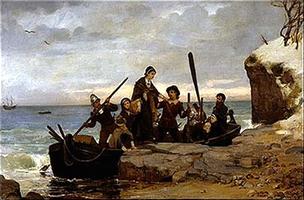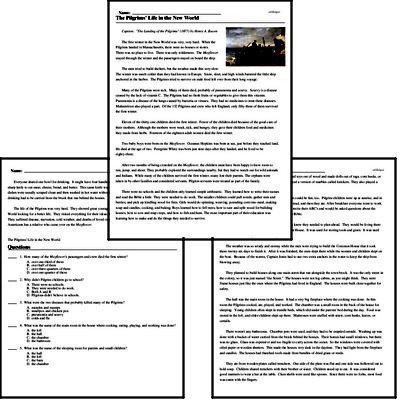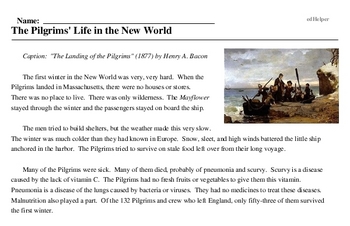The Pilgrims' Life in the New World
Caption: "The Landing of the Pilgrims" (1877) by Henry A. Bacon
The first winter in the New World was very, very hard. When the Pilgrims landed in Massachusetts, there were no houses or stores. There was no place to live. There was only wilderness. The Mayflower stayed through the winter and the passengers stayed on board the ship.
The men tried to build shelters, but the weather made this very slow. The winter was much colder than they had known in Europe. Snow, sleet, and high winds battered the little ship anchored in the harbor. The Pilgrims tried to survive on stale food left over from their long voyage.
Many of the Pilgrims were sick. Many of them died, probably of pneumonia and scurvy. Scurvy is a disease caused by the lack of vitamin C. The Pilgrims had no fresh fruits or vegetables to give them this vitamin. Pneumonia is a disease of the lungs caused by bacteria or viruses. They had no medicines to treat these diseases. Malnutrition also played a part. Of the 132 Pilgrims and crew who left England, only fifty-three of them survived the first winter.
Eleven of the thirty-one children died the first winter. Fewer of the children died because of the good care of their mothers. Although the mothers were weak, sick, and hungry, they gave their children food and medicines they made from herbs. Fourteen of the eighteen adult women died the first winter.
Two baby boys were born on the Mayflower. Oceanus Hopkins was born at sea, just before they reached land. He died at the age of two. Peregrine White was born just nine days after they landed, and he lived to be eighty-three.
After two months of being crowded on the Mayflower, the children must have been happy to have room to run, jump, and shout. They probably explored the surroundings nearby, but they had to watch out for wild animals and Indians. While many of the children survived the first winter, many lost their parents. The orphans were taken in by other families and considered servants. Pilgrim servants were treated as part of the family.
There were no schools and the children only learned simple arithmetic. They learned how to write their names and read the Bible a little. They were needed to do work. The smaller children could pull weeds, gather nuts and berries, and pick up kindling wood for fires. Girls would do spinning, weaving, pounding corn into meal, making soap and candles, cooking, and baking. Boys learned how to fell trees, how to saw and split wood for building houses, how to sow and reap crops, and how to fish and hunt. The most important part of their education was learning how to make and do the things they needed to survive.
Pilgrim children created their own fun. They whittled toys out of wood and made dolls out of rags, corn husks, or pine cones. They invented games to play. They played a version of marbles called knickers. They also played a game like soccer with anything that would roll.




